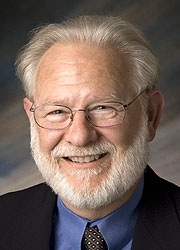
Ph.D. - 1973 - University of Iowa
Postdoc - 1973-74 -University of Iowa
The general thrust of the work in our laboratory could be characterized as the development of molecular probes to understand the role of brain monoamine neurotransmitters in normal behavior. Although molecular biology has made great strides in providing information about structural and functional aspects of the brain, those studies must be complemented through the use of specifically designed molecules that are directed toward particular biological targets. In an academic sense, such molecules are useful in gaining fundamental information about neuronal function. When one of them has high efficacy and low toxicity, however, it may become a drug candidate.
We have a particular focus on brain systems that utilize dopamine or serotonin as the neurotransmitter. In the former case, we are interested in molecular probes that have specificity for only one of the five general types of dopamine receptors (D1 - D5). Our efforts to date have led to several novel series of molecules that are full efficacy agonists at the dopamine D1 receptor subtype. One of these (named Dihydrexidine) showed remarkable efficacy in an animal model of late stage Parkinson's disease. A second-generation compound named dinapsoline has properties similar to dihydrexidine. Dinapsoline now has also shown dramatic efficacy in both rodent and primate models of Parkinson's disease. Recently we have developed yet a third series of related compounds based around a prototype named dinoxyline that is a sort of "universal" dopamine agonist. By appropriate structural modifications, these different templates have led to molecules with specificity for the D2 or D3 dopamine receptor isoforms.
We also have a continuing interest in the serotonin 5-HT1A, 5-HT2A and 5-HT2C receptors as likely targets for hallucinogenic/psychedelic substances and atypical antipsychotic drugs, and the possible roles that these receptor systems may play in normal cognitive function. These projects are comprised of systematic structural modification, coupled with pharmacological assay, with a view toward identifying structural determinants of the ligand binding domain in these receptors. One theme of this work has been to identify how molecules from different chemical classes can all be accommodated within the same receptor binding site. More recently we have been studying the second messenger systems that are coupled to the 5-HT2A receptor, and investigating their relative importance in the actions of hallucinogenic drugs. We have also developed a computer-based homology model of several G protein coupled receptors and are attempting to understand the functional elements within the receptor that are key to agonist activation.
D.E. Nichols. "Hallucinogens." Invited review for Pharmacology & Therapeutics, 101, 131-181 (2004).
R.A. Grubbs, M.M. Lewis, C. Owens-Vance, E. Arrington, A. Jassen, R.B. Mailman,and D.E. Nichols. "8,9-Dihydroxy-1,2,3,11b-tetrahydrochromeno[4,3,2,-de]isoquinoline (dinoxyline), a high affinity and potent agonist at all dopamine receptor isoforms," Bioorg. & Med. Chem., 12, 1403-1412 (2004).
D. Marona-Lewicka and D.E. Nichols. "Distinct temporal phases in the behavioral pharmacology of LSD: dopamine D2 Receptor-mediated effects in the rat and implications for psychosis," Psychopharmacology, 180, 427-435 (2005).
J.C. Parrish, M.R. Braden, E. Gundy, and D.E. Nichols. "Differential phospholipase C activation by phenylalkylamine serotonin 5-HT2A receptor agonists," J. Neurochem., 95, 1575-1584, (2005).
T. McLean, J.J. Chambers, J.C. Parrish, M.R. Braden, D. Marona-Lewicka, D.M. Kurrasch-Orbaugh, and D.E. Nichols. "C-(4,5,6-trimethoxyindan-1-yl)-methanamine: a mescaline analogue designed using a homology model of the 5-HT2A receptor," J. Med. Chem., 49, 4269-4274 (2006).
B. Chemel, B.L. Roth, V.J. Watts, and D.E. Nichols. "The "selective" 5-HT1A antagonist WAY-100635 and its metabolite, WAY-100634, are potent dopamine D4 receptor agonists," Psychopharmacology, 188, 244-251 (2006).
T.H. McLean, J.C. Parrish, M.R. Braden, D. Marona-Lewicka, A. Gallardo-Godoy, and D.E. Nichols. "1-Aminomethylbenzocycloalkanes: conformationally-restricted hallucinogenic phenÂethylamine analogues as functionally-selective 5 HT2A receptor agonists," J. Med. Chem., 49, 5794-5803 (2006).
J.P. Cueva, G. Giorgioni, R.A. Grubbs, B.R. Chemel, V.J. Watts, and D.E. Nichols. "Trans-2,3-dihydroxy-6a,78,8,12b-tetrahydro-6H-chromeno[3,4-c]isoquinoline; synthesis, resolution, and preliminary pharmacological characterization of a new dopamine D1 receptor full agonist," J. Med. Chem., 49, 6848-6857 (2006).
J.C. Parrish and D.E. Nichols. "Serotonin 5-HT2A receptor activation induces 2-arachiÂdonoylglycerol (2-AG) release through a Phospholipase C-dependent mechanism," J. Neurochem., 99, 1164-1175 (2006).
M.R. Braden, J.C. Parrish, J.C. Naylor, and D.E. Nichols. "Molecular interaction of serotonin 5 HT2A receptor residues Phe339(6.51) and Phe340(6.52) with super-potent N-benzyl phenethylamine agonists," Mol. Pharmacol., 70, 1956-1964 (2006).

